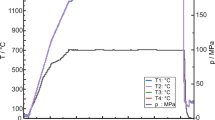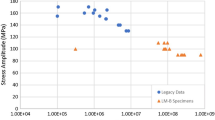Abstract
Subsurface fatigue damage, in the form of cracking of the α phase, was observed in Ti-6A1-4V during high cycle fatigue of total hip prostheses tested in a simulated physiological test geometry and environment. The subsurface cracking was found only in the region of highest fatigue stresses and was present in a zone between 50 and 700 μm beneath the surface. The density of these cracks appeared to depend on the fabrication process used to form the part, where the direction of forging deformation strongly influenced the texture and grain morphology of the near-α bimodal microstructure. A novel scanning electron microscopy (SEM) technique, using selected area channeling patterns (SACPs) and electron channeling contrast imaging (ECCI), is described and was used to determine the crystallographic orientation of the fracture plane in the a phase. The texture resulting from the forming operation appeared to be such that the basal pole of the hcp lattice became oriented in the direction of flow. Also, the deformation substructure (in the form of dislocation subcells) influenced the formation of the subsurface cracks. Observations based on four independent fractured grains, using the channeling analysis techniques, indicated that the fracture plane for these subsurface fatigue cracks is the pyramidal plane of the hcp lattice.
Similar content being viewed by others
References
A. Atrens, W. Hoffelner, T.W. Duerig, and J.E. Allison:Scripta Metall., 1983, vol. 17, pp. 601–06.
J. Ruppen, P. Bhowal, D. Eylon, and A.J. McEvily:Fatigue Mechanisms, J.T. Fong, ed., ASTM STP 675, 1979, pp. 47–68.
J.A. Ruppen, D. Eylon, and A.J. McEvily:Metall. Trans., 1980, vol. 11A, pp. 1072–75.
D.L. Davidson:Fatigue Mechanisms, J.T. Fong, ed., ASTM STP 675, 1979, pp. 254–75.
D.L. Davidson and D. Eylon:Metall. Trans. A, 1980, vol. 11A, pp. 837–43.
J.L. Gilbert and H.R. Piehler:Metall. Trans. A, 1989, vol. 20A, pp. 1715–25.
D.F. Neal and P.A. Blenkinsop:Acta Metall. 1976, vol. 24, p. 59.
M. Semlitsch and B. Panic:Eng. Med., 1983, vol. 12 (4), pp. 185–98.
J.L. Gilbert: Ph.D. Dissertation, Carnegie Mellon University, Pittsburgh, PA, 1987.
J.L. Goldstein:Practical Scanning Electron Microscopy, H. Yakowitz, ed., Plenum Press, New York, NY, 1976.
G. Thomas and M.J. Goringe:Transmission Electron Microscopy of Materials, John Wiley & Sons, New York, NY, 1979.
Author information
Authors and Affiliations
Rights and permissions
About this article
Cite this article
Gilbert, J.L., Piehler, H.R. On the nature and crystallographic orientation of subsurface cracks in high cycle fatigue of Ti-6Al-4V. Metall Trans A 24, 669–680 (1993). https://doi.org/10.1007/BF02656635
Received:
Issue Date:
DOI: https://doi.org/10.1007/BF02656635




